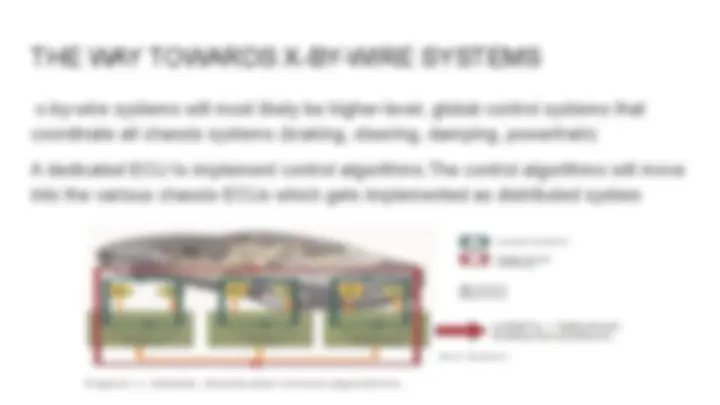








Study with the several resources on Docsity

Earn points by helping other students or get them with a premium plan


Prepare for your exams
Study with the several resources on Docsity

Earn points to download
Earn points by helping other students or get them with a premium plan
Community
Ask the community for help and clear up your study doubts
Discover the best universities in your country according to Docsity users
Free resources
Download our free guides on studying techniques, anxiety management strategies, and thesis advice from Docsity tutors
An overview of X-by-Wire Systems, focusing on their software architecture and development process. X-by-Wire Systems are higher-level, global control systems that coordinate all chassis systems, offering improved active safety and direct control over vehicle functions. the way towards X-by-Wire Systems, current network architecture, development process, topology, and software architecture components. It also covers the operating system, communication layer, and hardware abstraction layer.
What you will learn
Typology: Slides
1 / 12

This page cannot be seen from the preview
Don't miss anything!







x-by-wire systems will most likely be higher-level, global control systems that coordinate all chassis systems (braking, steering, damping, powertrain)
A dedicated ECU to implement control algorithms.The control algorithms will move into the various chassis ECUs which gets implemented as distributed system
● Single central ECU performing the entire control algorithm for a single mechanical or hydraulic subsystem.
● Star-topology wiring to the sensors and actuators connecting the ECU to the controlled system
● ECU is usually equipped with self-checking mechanisms (watchdog or dual CPU). If one of these mechanisms detects an error, the controller resets and remains passive.
● Star topology has better fault tolerance than other topology (Bus topology) ● A single component failure may only affect one connection between a node computer and the central star coupler ● By using appropriate strategies for redundancy ,failure of central star coupler can be resolved.
● The main objective of the software architecture is the re-use of individual functions, which are stored as software modules in a function repository
● Software carry-over parts (COP) that can be used multiple times across car lines and vehicle variants
● Open software architecture, which enables portability and re-use of individual software modules, ensures correct diagnosis of faults, and which supports safety and fault tolerance functions
Task Management : A task defines an autonomous single threaded piece of application software that is designed to potentially run in parallel with other tasks.Tasks are executed sequentially starting at the entry point and running to the exit point. Processing Levels :Each task and interrupt service routine (ISR) is statically assigned to one processing level that defines its priority. Further classified into 3 types
MIDDLEWARE LAYER : A middleware layer is responsible for the interaction between the communication network and the application software. For the application, communication across a data network must be equivalent to the inter-task communication that is done locally within a single ECU. It provides the necessary services to support fault-tolerant hard realtime distributed applications. In the following these services are described